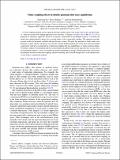Finite coupling effects in double quantum dots near equilibrium
Author(s)
Xu, Xiansong; Thingna, Juzar; Wang, Jian-Sheng
DownloadPhysRevB.95.035428.pdf (473.7Kb)
PUBLISHER_POLICY
Publisher Policy
Article is made available in accordance with the publisher's policy and may be subject to US copyright law. Please refer to the publisher's site for terms of use.
Terms of use
Metadata
Show full item recordAbstract
A weak coupling quantum master equation provides reliable steady-state results only in the van Hove limit, i.e., when the system-lead coupling approaches zero. Recently, J. Thingna et al. [Phys. Rev. E 88, 052127 (2013)PLEEE81539-375510.1103/PhysRevE.88.052127] proposed an alternative approach, based on an analytic continuation of the Redfield solution, to evaluate the steady-state reduced density matrix up to second order in the system-bath coupling. The approach provides accurate results for harmonic oscillator and spin-bosonic systems. We apply this approach to study steady-state fermionic systems and the calculation on an exactly solvable double quantum dot system shows that the method is rigorously valid up to second order in system-lead coupling only near equilibrium, i.e., linear response regime. We further compare to the Redfield and the secular Redfield (Lindblad-type) master equations that are inaccurate in all parameter regimes. Lastly, we consider the nontrivial problem of strong Coulomb interaction and illustrate the interplay between system-lead coupling, interdot tunneling, and Coulomb strength that can be captured only via the analytic continuation method.
Date issued
2017-01Department
Massachusetts Institute of Technology. Department of ChemistryJournal
Physical Review B
Publisher
American Physical Society
Citation
Xu, Xiansong, Juzar Thingna, and Jian-Sheng Wang. “Finite Coupling Effects in Double Quantum Dots near Equilibrium.” Physical Review B 95.3 (2017): n. pag. © 2017 American Physical Society
Version: Final published version
ISSN
1098-0121
1550-235X